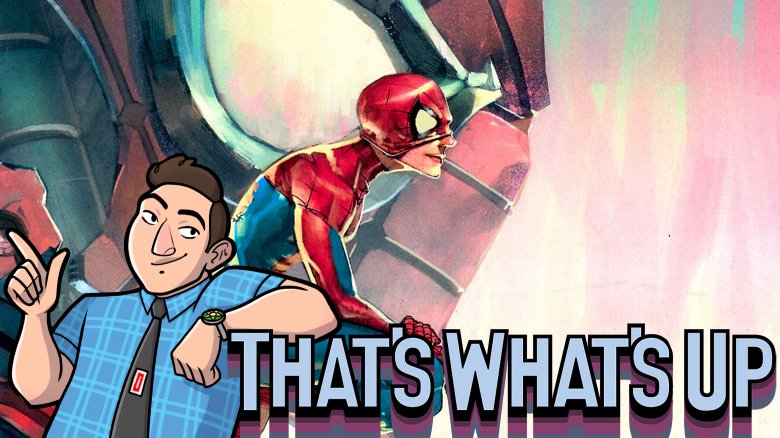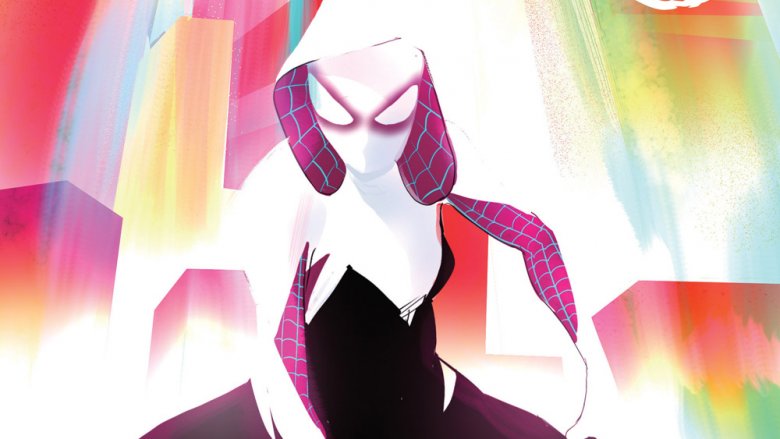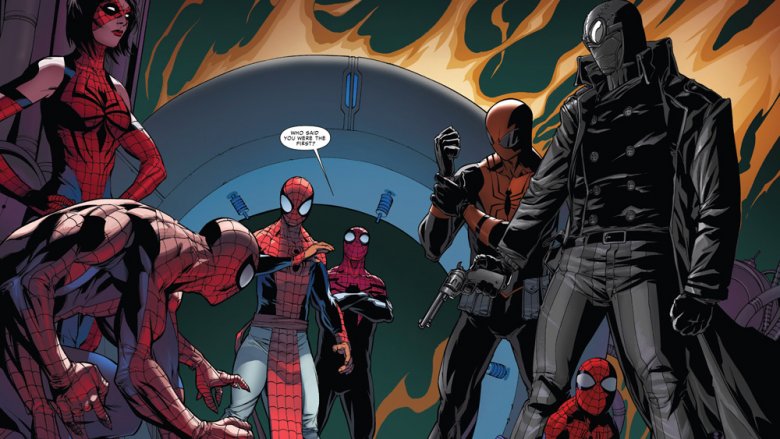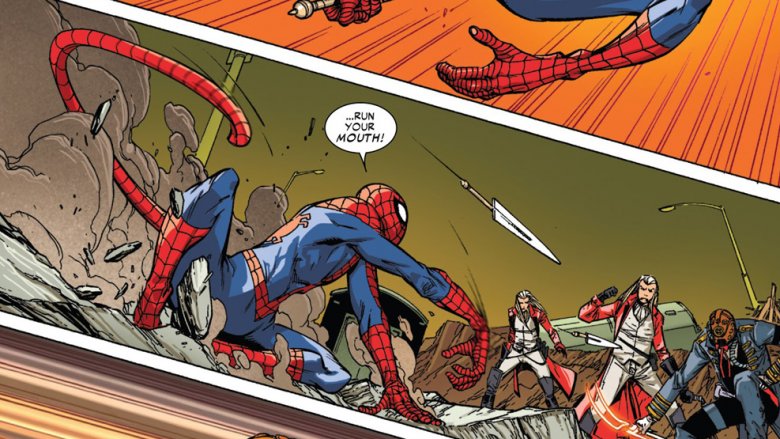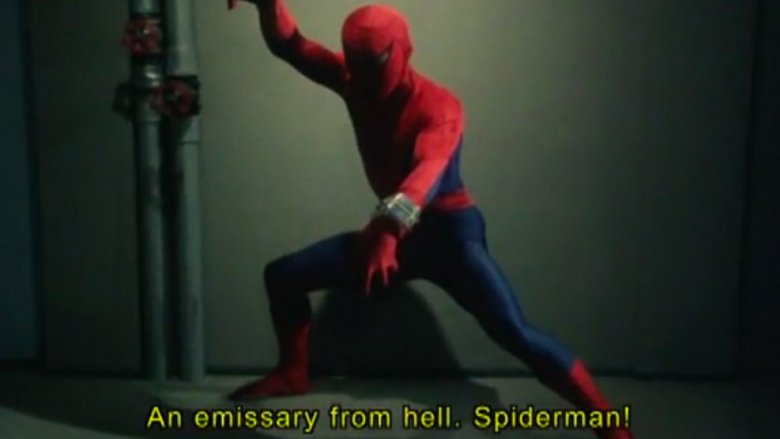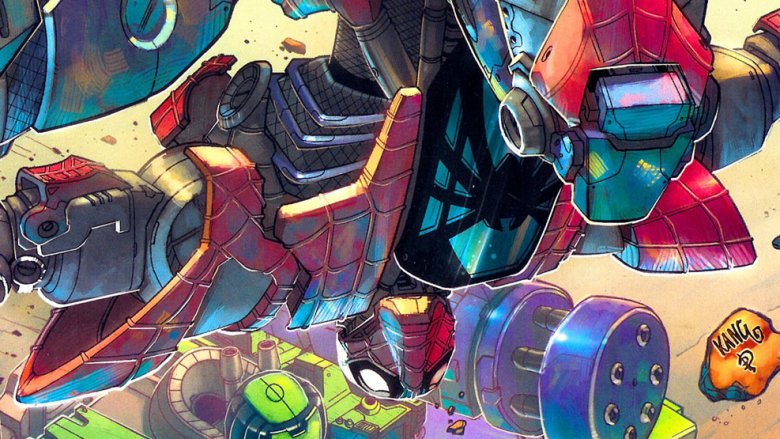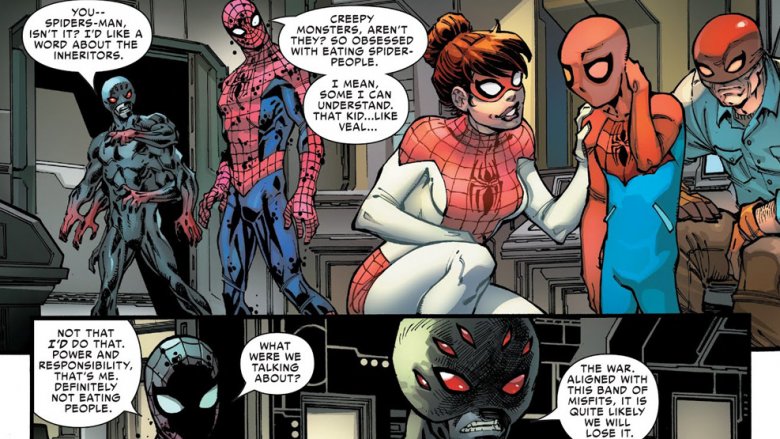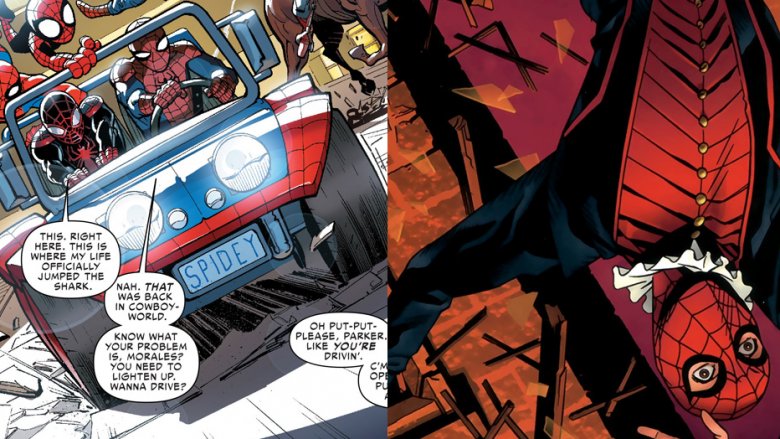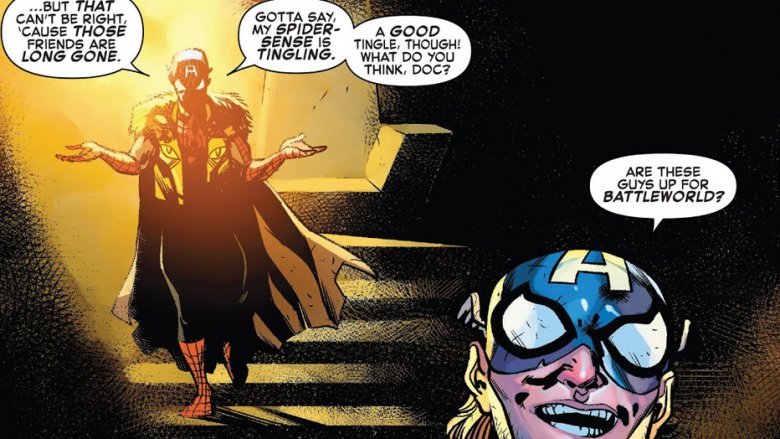That's What's Up: The Best Alternate Universe Spider-Men You've Never Heard Of
Each week, comic book writer Chris Sims answers the burning questions you have about the world of comics and pop culture: what's up with that? If you'd like to ask Chris a question, please send it to @theisb on Twitter with the hashtag #WhatsUpChris, or email it to staff@looper.com with the subject line "That's What's Up."
Q: I recently saw Into the Spider-Verse and loved it. Are there any other alternate-universe versions of Spider-Man that are worth knowing about? — @via email
Are there ever!
Before we go any further, I think we all need to take a moment to recognize that we are living in a world where there's a critically acclaimed, award-winning major motion picture that features Peter Porker, the Spectacular Spider-Ham in a spotlight role. Even after we had multiple movies about Rocket Raccoon and Groot raking in billions of dollars at the box office — even in the same days where you can go to the theater and see a movie with a 100% accurate version of Topo, Aquaman's drum-playing octopus sidekick from the '60s — that is worth appreciating.
The thing is, Spider-Ham isn't even close to being the weirdest or most notable offshoot of Marvel's flagship wall-crawler. There are dozens if not hundreds of alternate versions of Spider-Man out there, and more than a few of them are worth taking note of, whether it's because they're secretly really good, or just really, really weird.
Why are there so many Spider-Men?
The interesting thing about all the different versions of Spider-Man floating around is that more than any other superhero, all of these alternate Spider-Men actually feel like they matter... for certain values of "matter," anyway. Parallel dimensions and multiple Earths are, after all, a dime a dozen in superhero comics, and the more popular a character is, the more alternate versions of them you're likely to find. That said, with a very small handful of exceptions, they don't quite have the personality of the Multiverse's various Spiders-Men.
Take Batman for example. As DC's most popular character — and arguably the most popular superhero ever — there are about as many versions of him as there are of Spider-Man. But once you get through the big ones, like Dark Knight Returns, and the various live-action TV or cartoon versions, there's not a whole lot of personality there. I think a big part of that comes from the way that a good number of those stories are put together, by combining Batman with something that makes him, well, less Batman. If you make Bruce Wayne a Green Lantern, like in Darkest Knight, or make him a blood-drinking vampire who eats the Joker, like in Red Rain, to name two of the more notable ones, then he's not really Batman. If you put him in a world where America is ruled over by an authoritarian theocracy founded by Oliver Cromwell, that's a pretty interesting premise, but it's not going to hold your attention in the way that the core Batman will.
But something about Spider-Man is different, and we know that because there have been multiple successful ongoing series about those alternate-universe Spideys. Miguel O'Hara, Mayday Parker, and Gwen Stacy have all had relatively long-tenured and interesting careers as Spider-Man, -Girl, and -Woman respectively, and I have a theory about why that is.
What makes Spider-Man different?
On one level, he's a character who's almost entirely designed for one specific environment — all the wall-crawling and web-swinging really only work in a place like Manhattan, where there's a definite verticality of skyscrapers to climb and swing from. There are even jokes about that in the comics themselves, whenever he has to go somewhere that's not built entirely around tall buildings and has trouble getting around.
There's another level, though, where Spider-Man is one of the most universally understandable characters there is. It's not just the powers — although "pretty strong" and "can jump really high" are all things we can get on an instinctive level, and there are very few land masses on this planet without spiders — it's the themes. The saga of Spider-Man is fundamentally the story of someone who screws up and spends the rest of his life trying to be a better person, even when he doesn't always succeed. That's an incredibly easy thing to relate to; the only big difference between Peter Parker's screwups and our own is that he has the proportionate superpowers to mess things up on a much grander scale.
With that as the core idea, it's pretty easy to transplant the things that make Spider-Man the character he is into a different setup and still have it feel like Spider-Man. It's why the repetition of the origin stories in Into the Spider-Verse doesn't actually feel repetitive, and it's why there are so many memorable variations on that same thing. So let's talk about them.
Spider-Monkey
We might as well start with the weirdest one, and that is most definitely Spider-Monkey, who first appeared in the pages of Marvel Apes back in 2008. It was released as something of a goof on the then-wildly popular Marvel Zombies, and as the name implies, it's among the weirdest comic books Marvel has ever produced, and that's saying something. In case you're not familiar with just how bizarre their comics can get, consider the following: they've done comics set in their core, canonical universe about Captain America becoming a werewolf and the Punisher becoming a Frankenstein. It's honestly amazing that Iron Man's never been a mummy.
Unlike those stories, however, Marvel Apes was set in an alternate universe where — and there's no prizes for figuring this one out based on the title — all of the heroes were slightly anthropomorphic apes and monkeys. That, however, is just the first of two high concepts going on in that book. The twist is that they're not just apes, they are also vampires. No, seriously. This is a comic that exists, and it is bonkers.
Spider-Monkey doesn't have the cultural cachet of a Peter Porker (another one of those offshoots with a surprisingly long-running ongoing series of his own), and but I think there's a lot to be mined from a version of Spidey who isn't just a cartoon monkey, but whose world was also largely defined by the Avengers being run by blood-drinking super-vampires who straight up ate Doctor Octopus. It seems like he should have some things to talk about when the whole interdimensional family gets together.
An Emissary From Hell: Supaidaman!
My absolute favorite alternate universe Spider-Man is one who's made a mild resurgence in recent years: the live-action Japanese Spider-Man whose adventures ran for a single 41-episode season in 1978. He represents a very unusual twist on the usual adaptations of Spider-Man, in that he pretty much has nothing in common with his American counterpart outside of the name and the costume.
Takuya Yamashiro is a dirt-bike stunt rider who is granted great powers by Garia, an alien from the planet Spider, so that he can fight Professor Monster and Amazoness, the leaders of the Iron Cross Army. In addition to a familiar red-and-blue suit and the ability to climb walls, those powers also include a super-powerful flying car called the Spider-Machine GP-7, and a giant robot called Leopardon who dispatches his enemies with a massive slicing attack called Sword Vigor. In addition to being pretty ridiculously fun in its own right, Supaidaman is also historically significant. It comes in the early days of Japanese tokusatsu, the genre that would eventually give rise to what we in America know as Power Rangers, and was actually the show that introduced the idea of the hero summoning a giant robot to deal with a resurrected giant enemy.
I probably don't need to say this after that description, but just in case: it rules. Also, in a really interesting twist on the formula, it's Takuya's girlfriend, Hitomi, who's working as a photojournalist, and her equivalent of J. Jonah Jameson is secretly Amazoness. There's so much interesting stuff going on there that I've always been shocked that we haven't gotten some kind of revival already.
Marvel MegaMorphs
If you really want to have a version of Spider-Man with a giant robot (and let's be real here, we all do), then you don't need to go all the way to Japan to get it. Instead, you could go to the version of Spider-Man from Marvel MegaMorphs, a series that is as delightfully weird as only a comic based on a toy line based on a comic could be.
The toy line was a pretty simple concept; it's basically just Transformers but with the Marvel superheroes, leading to weird stuff like a Captain America mech that turns into a helicopter, and a Punisher toy that you can arrange into a robot with a gigantic gun where his human junk would be. As toys, they weren't great, but as a concept for a comic, it's amazing. My favorite thing about MegaMorphs is that it takes a pretty obvious question about the fiction of the Marvel Universe — why doesn't Tony Stark just build Iron Man suits for all of his friends so that they can be exponentially more powerful? — and takes it to the buck wild but completely logical extreme of asking why Tony Stark doesn't just build gigantic transforming Megazords for all of his friends instead. The result is a story where Doctor Octopus tries to steal the Statue of Liberty, and gets stopped by a group of heroic robots that include a 50 foot-tall on-fire motorcycle robot piloted by Ghost Rider, a literal demon from Hell. It's maybe the single best comic series that like 15 people read, including me and creators Sean McKeever and Lou Kang.
Anyway, Spider-Man's robot is a bit of a copout in that it turns from a giant robot Spider-Man into a giant robot spider, but what makes it great is that it's still piloted by a pretty straightforward version of Spider-Man. In other words, MegaMorphs is a book where Peter Parker, a complete disaster of a human being, has access to one of the Jaegers from Pacific Rim. That's the best.
Spiders-Man
The most recent alternate Spidey to catch my eye was only introduced a few months ago, but has quickly become one of my favorites: Spiders-Man of Earth-11580. Like Spider-Monkey, he's exactly what he says on the label. Rather than being a Peter Parker who was bitten by a single radioactive spider and granted superhuman powers, "he" is a whole bunch of radioactive spiders who completely devoured their world's Peter Parker, somehow absorbing his consciousness and deciding to put on a costume and pretend to be human so they/he could fight crime. Thus, Spiders-Man.
It's the kind of hilarious high concept that, in retrospect, is so obvious that it's amazing (and spectacular, and sensational) that it hasn't been done already, but it's so good. There's this delightful interplay between Peter Parker's consciousness, in that he's a capital-letter Good Person who just wants to help, and the fact that he's also a sentient swarm of man-eating spiders, meaning that their primary goal is to eat human beings. It's the kind of dynamic you don't get to see too often in comics. Plus, as a bonus, it's kind of a twist on one of my favorite Marvel villains: Swarm, the Nazi made of bees.
I'll admit that unlike, say, Spider-Gwen, Spiders-Man is probably best used sparingly. When you get right down to it, he's really only one single joke, and works best in the context of being the weirdest member of a crowd where the baseline of weirdness is already pretty high. Still, though, it might be one gag, but what a gag it is.
The Spider (1602) and the Spider-Buggy
While we're on the subject of great one-note gags, I'd be remiss if I didn't mention two versions of Spider-Man that I absolutely love for a single, highly specific reason: the Spider and the Spider-Buggy. The former was introduced in Marvel's 1602 event, which reimagined all of their heroes as though they'd been around back in Pilgrim times, which mostly amounted to changing their names to old-timey versions like "Peter Parquagh" or "Scotius Summerisle." The latter was reintroduced in the Spider-Verse crossover, and is basically a sentient version of Spidey's old wall-crawling dune buggy, which has been a punchline ever since it was introduced, with a little bit of Speed Buggy thrown in for good measure. They're not quite as memorable or deep as the other entries on this list, but here's why they're worth keeping around:
1: The sound effect for Spidey 1602's webs is "thwippe" instead of "thwip," because that's how it would've been written back then.
2: The Spider-Buggy's canonical civilian name — which is weird because he is an automobile and so the concept of having a secret identity is pretty weird to begin with — is "Peter Parkedcar."
That's... that's fantastic.
Apocalyptic Spider-Man
Up until now, I've been talking about alternate versions of Spider-Man that are still heroic, because that's the throughline that unites almost all of the Spideys that have shown up in various pieces of the multiverse. A list like this seems incomplete, though, without one of those versions that's gone horribly wrong. That is, after all, one of the primary reasons to have a multiverse to begin with, and there have been countless stories about what would happen if the heroes went bad — there's a pretty major Hulk villain called the Maestro who's just an evil smart Hulk from an alternate future, and there are enough "what if Superman was eeeeevil" stories that at this point, it's a cliché.
Spider-Man doesn't get that a lot, but he did in a story from Chip Zdarsky and Ramon Perez for Marvel Two-in-One, and it's genuinely great, primarily because we don't really know what drove this Peter Parker to be who he is. All we're told is that he's the Spider-Man of a world where Captain America and Iron Man's "civil war" blew up into an actual apocalyptic war that nearly destroyed the world, and that he ended it by killing Tony Stark and imprisoning Steve Rogers, who we never see in the story. The implications are clear. That war caused him to lose something — to lose everything — and decide that he needed to take on the great responsibility of protecting the world from its greatest threat: superheroes. Which means making them kill each other in gladiatorial games while he's dressed in the tattered costume pieces of his fallen foes.
What makes this Spider-Man so interesting, even beyond the novelty of seeing an evil, world-conquering Peter Parker, is that he's presented as the unquestioned master of his world. Even Doctor Strange, who lost an eye in this unseen conflict and has replaced it with the Eye of Agamotto, is serving this Spidey as an underling. It gives us just enough to fill in those blanks ourselves, making the reader answer the question of what Spider-Man lost in that conflict, but it also works with the core of the character. It's a reminder of the fact that when Peter is focused on a goal, there's nothing that can stop him — the core tenet of Spider-Man that forms the backbone of Into the Spider-Verse.
Each week, comic book writer Chris Sims answers the burning questions you have about the world of comics and pop culture: what's up with that? If you'd like to ask Chris a question, please send it to @theisb on Twitter with the hashtag #WhatsUpChris, or email it to staff@looper.com with the subject line "That's What's Up."
